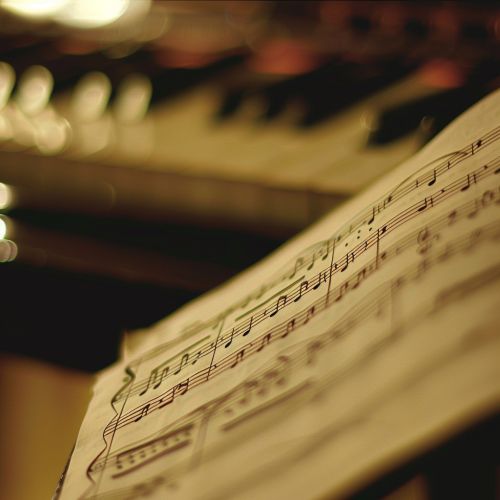Music
Overview
Music is an art form and cultural activity whose medium is sound organized in time. General definitions of music include common elements such as pitch (which governs melody and harmony), rhythm (and its associated concepts tempo, meter, and articulation), dynamics (loudness and softness), and the sonic qualities of timbre and texture (which are sometimes termed the "color" of a musical sound).
Elements of Music
Pitch and Melody
Pitch is an aspect of a sound that we can hear, reflecting whether one musical sound, note, or tone is "higher" or "lower" than another musical sound, note, or tone. We can talk about the highness or lowness of pitch in the more general sense, such as the way a listener hears a piercingly high piccolo note or whistling tone as higher in pitch than a deep thump of a bass drum.
Melody is a linear sequence of musical tones that the listener perceives as a single entity. In its most literal sense, a melody is a combination of pitch and rhythm, while more figuratively, the term can include successions of other musical elements such as tonal color.


Harmony
Harmony refers to the process by which individual sounds are superimposed. In music, this is often the structure of chords and their progression. Harmony can also refer to the horizontal aspects of music, such as counterpoint.
Rhythm
Rhythm is the arrangement of sounds and silences in time. Meter animates time in regular pulse groupings, called measures or bars. The time signature, sometimes called meter signature, is represented as a fraction, the lower number representing the note value, and the upper number determining how many of these note values constitute one bar.
Dynamics
In music, dynamics normally refers to the volume of a sound or note, but can also refer to every aspect of the execution of a given piece, either stylistic or functional. The term is often shortened to 'dyn.'.
Timbre
Timbre is the perceived sound quality of a musical note, sound or tone. Timbre distinguishes different types of sound production, such as choir voices and musical instruments. It also enables listeners to distinguish different instruments in the same category.
History of Music
Music has been an integral part of societies worldwide since prehistoric times. The earliest known musical instruments date back approximately 40,000 years, and the first musical notation system was created in Uruk, in present-day Iraq, around 2000 B.C.
Prehistoric Music
Prehistoric music is a term in the history of music for all music produced in preliterate cultures, beginning somewhere in very late geological history.
Ancient Music
Ancient music is music that developed in literate cultures, replacing prehistoric music. This period includes music from Ancient Greece, Ancient Rome, Egypt, and Mesopotamia.
Medieval Music
Medieval music includes Western music written during the Middle Ages. This era begins with the fall of the Western Roman Empire and ends sometime in the early fifteenth century.
Renaissance Music
Renaissance music is European music written during the Renaissance, approximately 1400 to 1600. Defining the beginning of the era is difficult, given the lack of abrupt shifts in musical thinking during this period.
Baroque Music
Baroque music is a style of Western art music composed from approximately 1600 to 1750. This era followed the Renaissance and was followed in turn by the Classical era.
Classical Music
Classical music is art music produced or rooted in the traditions of Western culture, including both liturgical (religious) and secular music. The term "classical music" did not appear until the early 19th century, the time from which the Classical period in Western music is generally dated.
Romantic Music
Romantic music is a stylistic movement in Western orchestral music associated with the period of the nineteenth century commonly referred to as the Romantic era.
20th and 21st Century Music
20th-century music brought a new freedom and wide experimentation with new musical styles and forms that challenged the accepted rules of music of earlier periods. The invention of musical amplification and electronic instruments, especially the synthesizer, in the mid-20th century revolutionized popular music and accelerated the development of new forms of music.
21st-century music is art music, in the contemporary classical tradition or by postmodernist and experimental composers, and includes a wide variety of popular music genres.
Music and Culture
Music is an important part of the culture of every society. It is used in a wide variety of contexts, from ceremonial purposes to entertainment. Music can be a way to communicate, to tell a story, or to express emotion.
Music Theory
Music theory is the study of the practices and possibilities of music. It is derived from observation of, and involves hypothetical speculation about how musicians and composers make music.
Music Education
Music education is an important aspect of providing children with a well-rounded education. When allowed to work in harmony with other subjects and areas of study, music helps children grow in self-esteem, build essential skills and prepare for bright futures.
